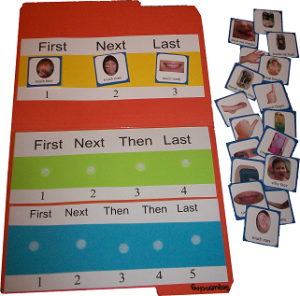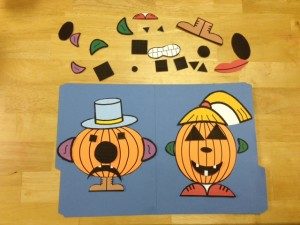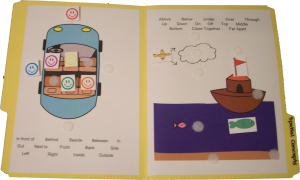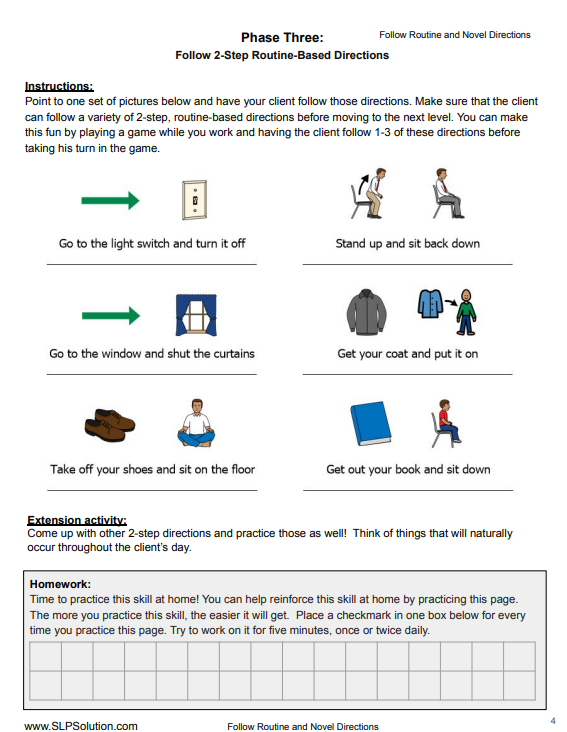Speech Therapy for Following Directions:
Being able to understand and follow verbal directions is a huge communication skill! Children with language delays may struggle to follow directions at home, in the classroom, and in our speech/language therapy sessions. We can help children learn this skill by building it up slowly over time. Here are our resources for helping a child learn to follow directions.
Do your child’s language delays cause him to have difficulty following directions? This can make it very hard to get through your daily routines and get through errands without meltdowns and problems. Follow these steps to help teach your child to follow directions at home and in public.
Following Directions Step 1:
Take Pictures of Common Directions
Throughout the course of a day or a week, write down all of the directions that you commonly give your child. Take notes on your phone or on a piece of paper you carry around with you. Try to capture the meaning of the direction in as few words as possible. For example, if you give your child the direction “Honey, would you mind going to get your shoes for me please?”, just write down “get shoes”. That will be the direction you will give your child while teaching her these directions.
You may have a list of directions like “come here”, “stop”, “go”, “walk”, “stand up”, “sit down”, “stay here”, “hold my hand”, etc. If you’re having trouble picking directions, try thinking about what times of the day or during which activities your child has the most trouble following directions.
Take/Make Pictures of Those Directions
Choose about 15-20 of the most common directions. You’ll want to start by just teaching your child a few of those, but you may as well make all of the pictures now so you have them when you need them. Now you’ll need to create a visual cue for each direction. You can do this a couple of ways. You could take a picture of your child doing each of those things and print them out with the direction written on or under the picture. Y
ou could also go on google image search and find pictures of other kids or people following directions to complete those actions. Finally, you could always just draw stick figures on a card for each direction, though depending on your artistic abilities and your child’s ability to decipher your drawings, you may be better off with real photos. 🙂 Once you print the directions off, cut them out so each direction is on its own card.
Following Directions Step 2:
Practice Following Directions in an Isolated Setting
Your child will need to be taught what each of these cards means. You can do this by playing Simon Says using the cards. For those of you who don’t know, Simon Says is a game where one person is chosen to be the leader, “Simon”, and everyone else must do what Simon Says. However, the leader must say “Simon Says” before each direction is given. If the leader does not say “Simon Says” and the followers complete the direction anyway, they lose. With young children, I disregard that last part about losing. I just always say “Simon Says” and then after a while we switch and let someone else be leader. For that matter, you don’t even have to say Simon Says, just tell your child it’s a game and he’ll probably be happy. Each time you give a direction, show your child the picture along with it. At first, you will need to help your child do each one until she is able to do it on her own. After she completes the action, whether she did it on her own or you had to help her, clap and get very excited for her. This will help reinforce that she’s doing something great by following directions! You may want to start with just a few directions until your child learns those well and then add in more.
*** Adaptation for children with autism: Many children with autism won’t understand the whole “game” aspect of making this fun. For these children, you will want to find something that they really enjoy so they have something to work for. For example, if he really likes that toy that lights up, hide it for a while before you do this activity and every time your child follows a direction (even if you have to help him do it), give him the toy as a reinforcer. If your child isn’t very motivated by objects, you may have to try giving him a small piece of his favorite food or drink after each direction.
Following Directions Step 3:
Practice Following Directions in Daily Routines
Once your child can follow the set of directions during these games and play sessions with you, start using the directions during your daily routines. Whenever you need to give your child one of those directions, show her the picture card as you do. Then, help her complete the direction and get excited for her just as you did before.
For children with autism or children that have a lot of trouble with this, you may need to give a small reinforcer after they complete the direction until they get the hang of it. Mini M&Ms are great for this because they’re small and won’t ruin your child’s appetite. You may want to consider hanging a set of the following directions pictures from your belt loop so that you have them nearby. At my school, I have a set of picture directions on a ring that is clipped to my belt with one of those retractable keychains so I can whip it out whenever necessary. Keep doing this until your child is following directions with the picture cue throughout your daily routine (that may take a while, be patient!)
Following Directions Step 4:
Fade the Picture Cue
Once your child can follow the directions with the picture cue, you will want to fade the use of the picture so that your child can follow the verbal direction without needing a picture. To do this, try giving the direction verbally first without using the picture. Pause for a moment and see if your child will do it. You can try nudging him in the right direction or making a small gesture toward the desired action. If your child is not able to do it, give the direction again but this time use the picture.
Try a variety of different cues, such as laying your hand on your child, pointing at what he needs to do, etc. Vary your reinforcement so that when your child follows the direction with fewer cues, you give more praise and get more excited for your child than when you have to give him a lot of cues. If you keep doing this long enough, your child should be able to follow the directions without needing too many additional cues.
Following Directions Step 5:
Work on Following Directions with More than One Step
Once your child is able to follow single-step directions using this method, you can use the same approach to teach multiple-step directions. For this, you will want to do the following directions game with two pictures and teach her how to follow both parts of the direction. You could even use a first, then board to help her understand the order of the directions. Follow the same procedure for fading off the visuals and working it into daily routines.
PS. If you have patience and continue to use this method consistently throughout your day, you will see great changes in your child’s ability to follow your directions. Just make sure to keep it fun and light and provide tons of encouragement! If you are looking for materials that you can use to teach your child to follow directions, download my sequencing board with following directions card set that you can print for free and use at your house or in your therapy setting!
Free Therapy Materials for Following Directions:
Check out the freebies that we have inside our Free Therapy Material Library!

Sequencing Board with Following Directions Cards

Pumpkin File Folder Game with Following Directions Activity

Where Does it Go? Spatial Concepts Game with Following Directions Activity

About the Author: Carrie Clark, MA CCC-SLP
Hi, I’m Carrie! I’m a speech-language pathologist from Columbia, Missouri, USA. I’ve worked with children and teenagers of all ages in schools, preschools, and even my own private practice. I love digging through the research on speech and language topics and breaking it down into step-by-step plans for my followers.
Connect with Me:









Such amazing advice, will be trying this with my 2 year old. Thank you.
You are more than welcome, Natasha! Please let us know if you have any questions we can assist you with.
Hello!
I am currently a Pre- K teacher at Cadence Academy Preschool and I had a question for one of my students. Currently, I have a new student who is struggling compared to the other students. After working with him for the past month, he will now hold a pencil correctly, use a glue stick, attempt to color correctly, attempt to write his name, and attempt to write in his journal (When he came to our school, he did not understand tracing and now there is some tracing/ some writing). He knows half of his ABC’s and most numbers from 1-20. He will participate at circle time, and today, he told me it was September and recognized some sight words when shown.
My problem seems to be when given more basic commands such as: get an eraser from the basket, or put your backpack in your cubby, or can you pick up the puzzle piece. When asking him to perform a basic task, he looks very confused, cannot follow through to the correct bucket for the eraser, or has trouble understanding. He sometimes mumbles or sounds much younger than his age when talking. He does not like loud noises/ talking and will cover his ears when this happens. He will play nicely with peers and sort/ organize the toy buckets. He is willing to help me when needed.
It is odd that he can sort/ clean a big mess involving several toy buckets, but can not follow or understand more basic commands. I was just wondering if you had any input on how I can help him become more confident in this area so I can prepare for his kindergarten year next year?
Hello, Christina!
Thank you so much for reaching out. Unfortunately, we get a ton of questions every day about how to solve specific speech/language problems. Since we have such a small staff, we aren’t able to answer every question that comes through on the website, social media, or via email. If you are a parent, we suggest you reach out to a local speech-language pathologist who can work with your child directly and answer your question.
If you are another speech-language professional, we have created a membership where we pay a full staff to answer questions like this on a regular basis. We would be more than happy to answer your question inside the membership program. We’re able to answer more questions in here because we have a full library of questions that we’ve already answered so our staff can either link you to the answer if it exists, or write you a custom response if needed. We’d love to see you inside the membership!
Click Here to Become a Member: https://www.slpsolution.com/#memberships